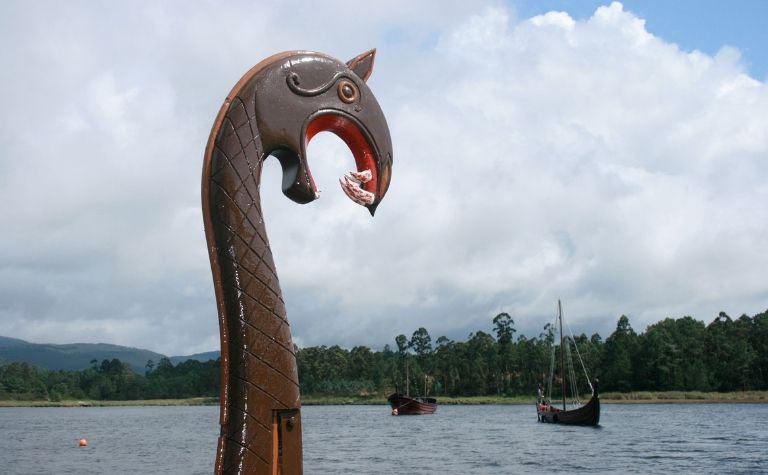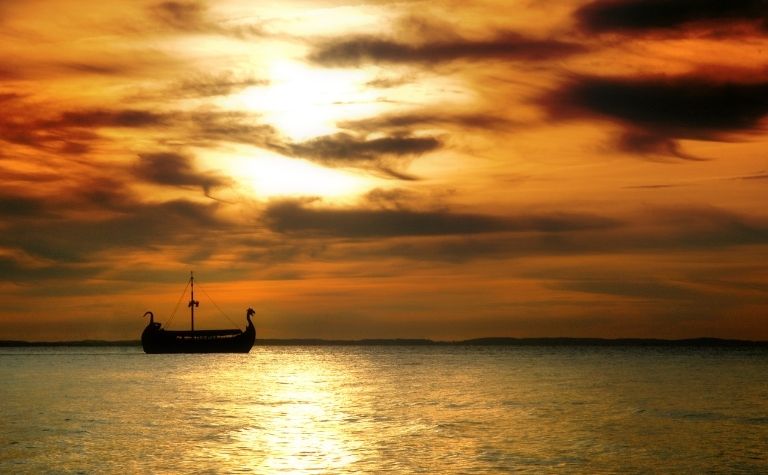Mention of the Vikings conjures images of fierce, helmet-clad warriors traveling in longboats pillaging as they went.
Also called Norseman, these warriors raided and colonized vast areas of Europe between the 9th and 11th centuries and profoundly influenced European history.
Although archaeological evidence and spoken fables confirm that Leif Eriksson was the first Viking to set foot in America, there is no proof that his purpose was anything other than to explore the lands to the West of Greenland.
Vikings landed in America in 1,000 A.D.
Why did the Vikings go to North America? Where did the Vikings land in North America? Did the Vikings have the ability to colonize America?
Keep reading to learn the answers to these questions and others.
Also see Were the Vikings Afraid of Anyone? to learn more.

Why did the Vikings go to North America?
The word Viking is old Norse, which usually means “pirate” or “raider,” and folklore and legend have given the Vikings a fearsome reputation over the centuries.
After Charlemagne’s death on January 28, 814, the Vikings began to carry out hit-and-run raids, eventually colonizing vast swathes of Northern Europe.
Vikings traveled the seas in wooden longships powered by sails and rowers.
After their success in Europe, the Vikings set out on longer trips and landed in Iceland in the 9th century, and in the 10th century, they reached Greenland.
It was not until the 12th century that Scandanavian history was committed to paper before these tales of historical events were verbally handed down to future generations.
Two of these tales (sagas) give differing accounts of how Leif Eriksson landed in North America.
Leif Eriksson’s father, Erik, the Red, was the first to land in Greenland after being exiled from Iceland, in approximately A.D. 985, for killing a neighbor.
This family seemed to have had anger issues because Leif Eriksson’s grandfather had originally been banned from Norway for committing a similar crime.
Leif was born in Greenland and returned to his ancestral Norway on reaching adulthood.
In Norway, King Olaf I Tryggvason converted him to Christianity and mandated him to spread the gospel to other lands.
Also see Did the Vikings Share Their Wives? to learn more.
The First Version – The Saga of Erik the Red
The first tale is “The Saga of Erik the Red”, where it is claimed that they sailed off course and ended up mistakenly landing in North America on their return voyage from Norway.
The Second Version – Saga of the Greenlanders
The second is provided by the story “Saga of the Greenlanders.”
This tale states that Eriksson had heard of a land to the west from an Icelandic trader called Bjarni Herjolfsson.
This version claims that Eriksson bought the trader’s ship and, with a crew of 35 men, arguably became the first Europeans to set foot in America.
The Vikings only remained in America for a decade before leaving it, never to return.
Also see Did the Vikings Celebrate Birthdays? to learn more.

Where Did The Viking Land In North America?
Leif Eriksson’s first landed in present-day Canada, which they described as a “rocky and barren” land.
Appropriately he christened it “Helluland,” which means “Stone Slab Land.”
Based on the description of this land, it is generally believed that he landed on Canada’s largest island, Baffin Island.
From the base at Baffin Island, archeologists have generally agreed they moved in a southerly direction to land they described as “Markland,” which means Forestland.
It is presumed that this was Newfoundland and Labrador, where they set up camp.
The Vikings spent the winter on an island in Newfoundland, which had milder weather patterns than Greenland.
They explored the surrounding areas and came upon an idyllic land called “Vinland,” which means Winelands.
Sagas describe Vinland as it as having:
- Idyllic landscape with lush meadows
- Rivers filled with Salmon
- Significant quantities of grapes and berries were growing in coastal pools
The grapes were suited to making wine, hence the name Vinland.
These descriptions match the conditions at the Miramichi River in New Brunswick.
This location is further confirmed as the Viking sagas describe the natives (Skraeling) as using skin boats.
Native Americans in this area were known for their canoes made from hides, unlike other tribes who used hardbottom canoes made from birch bark.
The specific tribe that used hide-covered boats was the Mi’kmaq, and the area around the Miramichi River had the largest population of these people.
Also see What Do Scandinavians Think of the Vikings? to learn more.

Did The Vikings Have The Ability To Colonize America?
The Vikings were in America for approximately ten years — specifically, Leif Erikson and his extended family.
There are three theories why the Vikings didn’t colonize America.
The Vikings Who Landed In America Were Explorers
The Vikings never intended to stay in Vinland permanently, but it was an exploratory journey.
Most archaeological evidence has found that the buildings were constructed on the shoreline.
The theory is that if they intended to colonize America, there would have been evidence of more structures built inland.
Unlike Greenland and Iceland, they built no independent farmsteads or livestock management areas in Vinland.
The position of the buildings suggests their function was to act as a shipping way-station rather than as a permanent long-term settlement.
The Native Americans Did Not welcome The Vikings.
The Vikings experienced intense opposition from the native Americans, specifically the Mi’kmaq people.
In their first encounter, the Vikings came across 10 Mi’kmaq sleeping under their canoes — and the Vikings killed them.
The Indians returned in force, and even though they did not have steel weapons, they had a numerical advantage. It wasn’t the start of a long and beneficial friendship.
There were attempts to trade with each other, but the Vikings felt menaced and outnumbered, and the Indians did not appreciate their presence.
Also see Were the Vikings German? to learn more.
There Were Insufficient Logistical Resources
If the Vikings had intended to subdue the native Americans, they would have needed three things:
- They would have needed a more significant force of men
- They would have needed constant reprovisioning of weapons and food supplies
- They would have needed ongoing shipments of more people to populate the land
The technology that allowed Columbus to establish settlements and maintain them did not exist in that period.
The distances the supply roots would have had to cover were:
- Baffin Island to Greenland is 1,310 km
- Greenland to Iceland is 1,210 km
- Iceland to Norway is 1,472 km
The supply roots would have been overwhelming for the Vikings.
After ten years, the Vikings left and returned to Greenland.
The Vikings did return to North America, but only to trade. They never settled again.
Were The Vikings The First Europeans In America?
Christopher Columbus supposedly discovered America in 1492.
There is good evidence that these were not the first Europeans to land in North America.
Also see Did the Vikings Name Their Ships? to learn more.
The First Europeans In America May Have Been Irish Monks
Latin texts called “Navigatio Sancti Brendani Abbatis” state that in the sixth century, an Irish Monk named Saint Brendan sailed to North America and made a seven-year voyage across the Atlantic Ocean to a new land on a wood-framed skin-covered boat called a currach.
Brendan did exist and is known to have traveled extensively in Europe. But no proof or evidence can be tested that he ever set foot on American soil.
To try and prove that the trip was possible, in 1976, Tim Severin, a British explorer, historian, and writer, attempted to recreate the voyage.
Severin, with three crew, traveled for thirteen months in a leather-clad vessel, identically matching “Brendan’s craft,” and finally reached Canadian shores. Although there is no solid evidence, this proves that such a trip was viable.
The Vikings Landed In The 10th Century
As discussed in this article, the Vikings did land in America in 1021 A.D. and remained based there for approximately ten years.
Christopher Columbus Arrived In 1492
When Christopher Columbus arrived in America, the proposition differed from the Vikings.
Europe was in an expansionist phase and actively sponsored expeditions to open up new trading routes.
When Columbus arrived in America, his approach was peaceful, and the trade between the Native Americans and the Europeans thrived.
It wasn’t all good news because, along with the trading opportunities, the Europeans also exported diseases responsible for killing over 90% of the Native American population.
Conclusion
A couple of indisputable facts include proof that the Vikings did land on North American shores; they remained for approximately ten years. Apart from short trading trips, they never returned.
Also see Vikings vs Spartans: Similarities and Differences? to learn more.
